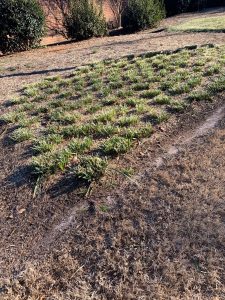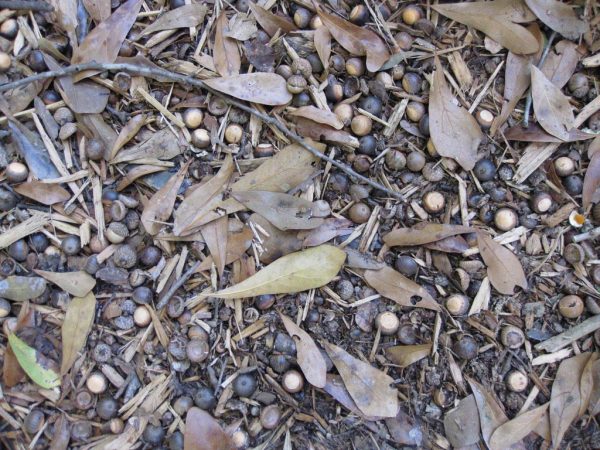Mowing Liriope in Spring

Cold weather can leave liriope (commonly called monkey grass) in tatters. Flower bed edging and driveway borders can be come overgrown and unkempt if the liriope is not kept compact. The best time to trim monkey grass is January – March. If you can adjust a lawn mower to its highest setting, it can be used to remove all of the old greenery from the last few years. New sprouts have not emerged yet and will not be harmed by the mower. If you wait much later, the trimming must be done with a hedge trimmer, after first checking to see how tall the new sprouts have grown. Make your cuts just above these sprouts.
Q.When do I cut back my liriope?
A.Start sharpening your shears! If your monkey grass is bedraggled or uneven, a Marine “brush cut” might help them. Look inside your plants to be sure no new green sprouts are emerging. Use hedge shears to make a flat cut 3″ high (or just above new sprouts). Some folks just set their lawn mower to its maximum height and use it to prune off the old growth.
Q: I’m having a terrible time with liriope that is sprouting up all over my yard. Most of the landscape is either pine straw beds or English ivy. I have begun digging up patches of the liriope and then putting down weed fabric covered with straw. This is very labor intensive and the liriope still seems to find escape routes. What is the best way to tackle it? Can I just put the weed fabric directly over it without digging it up, or will Roundup affect it ?
A: You may be dealing with the “evil twin” syndrome! Like Dr. Jekyll & Mr. Hyde, “clumping” monkey grass (Liriope muscari) has an evil twin: “spreading” monkey grass (Liriope spicata). The previous inhabitants of my house were unaware of this when they used monkey grass to line the front lawn and backyard nature trail. Along the trail, the liriope clumps faithfully for ten yards but at one spot it aggressively invades my ferns and azaleas for ten feet from the trail.
The two are very similar in appearance. I tell them apart by the width of the leaf: creeping liriope has leaves only one-eighth inch wide, clumping liriope leaves are one-fourth inch or more in width. Creeping liriope flowers are usually white or light lavender. If you’d rather not dig it up, you can achieve control of either liriope with a bit of patience. Spray it with glyphosate (Roundup, KleerAway, etc) three times a year, in spring, summer and fall. Monkey grass will take several weeks to die but you will gradually beat it back in a couple of years. I doubt that covering it with landscape fabric will work.
Q: I seem to have two kinds of liriope. One kind grows in a clump and doesn’t spread much. The other kind has spread from the liriope border deep into my flower bed and I can’t stop it! Is this normal? Is there a weed killer that works?
A: You’re right – there are two kinds of liriope! Most people are familiar with (Liriope muscari). It makes a nice evergreen clump and is widely used as a border plant or as a ground cover in shade. The other kind of liriope is (Liriope spicata), also called creeping liriope. As you have found out, it spreads rapidly and can be a pest when planted in the wrong place. Creeping liriope has a narrower, lighter green leaf than common liriope. Either one is tough to control with weed killer. The best technique would be to clip the leaves and wait for them to re-sprout, then use glyphosate (Roundup) or diquat (Next Day) on them. Nearby flowers can be shielded with a piece of cardboard. One spraying will not be enough – you’ll need to keep a constant watch this summer until the creeping liriope is totally eliminated.
Q: I have a recently planted bank of liriope. It is being invaded with unwanted grass and weeds. What can I use to kill the weeds and grass and not hurt the liriope? My dilemma is that I am wondering if liriope would be classified as a grass.
A: Grass-B-Gon and Vantage are possibilities. Read their labels to see how to use.
Q: Is there any weed killer that will kill liriope in my flower beds?
A: Liriope is tough to kill. The waxy leaves and tuberous roots help it resist most herbicides. Glyphosate (Roundup, etc) will kill it with two applications. Make a shield out of cardboard to protect your flowers when you spray. You should see some yellowing of the liriope within a week. Not all of the liriope will be killed; you’ll need to spray again a month later. A clean-up spray next spring should take care of any surviving sprouts.
Q: Something is eating my liriope on the tops. Could it be rabbits or possum? We have seen both in the yard at times.
A: More than likely it’s the rabbits that are eating your liriope. They look so cute until you see what they can do to a garden in just one night. The munching won’t hurt the liriope, unless it is severe. You can try sprinkling some hot red pepper around the liriope to discourage the munching.
It’s getting close to the time to mow/cut your liriope. If you mow, set your mower on the highest setting possible. The shortened liriope may discourage the rabbits also.




















